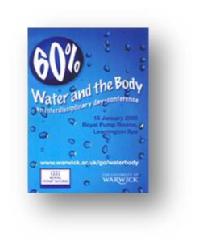60%: Water and the Body
Interdisciplinary day-conference
Saturday, 15 January 2005
The Assembly Rooms, The Royal Pump Rooms, Leamington Spa
The Art Gallery and Museum at The Royal Pump Rooms and the Centre for the History of Medicine at the University of Warwick jointly organised this interdisciplinary day-conference to explore the theme of water and the body in art and medicine, concluding in a general discussion.
Speakers
Alastair Durie (formerly Senior Lecturer in History, University of Glasgow)
Water is Best: Hydropathy in Britain, 1840-1914
Hydropathy arrived in Britain in the early 1840s from Austria, offering an alternative to conventional medicine. The strongest support came from the professional and middle classes, particularly those committed to the temperance cause who approved the ‘no alcohol’ rule which complemented the core therapeutic regime of baths, sweating and massage. Eventually hydropathy worked its way towards respectability as the hydros broadened their focus away from cure to sober recreation.
Shelley Sacks (Artist)
The Thought Bank
The ‘memory of water’ – or the capacity of water as a medium to carry non-material information – lies at the heart of the Thought Bank project. Through a process of ‘memory work’ and ‘rethinking’, in which painful images retrieved from a local water source are transformed into potentised water, a form of homeopathic remedy is created that contains images of how things could be different. The project evolved from an intuitive sense of how thought imprints upon water, to encompass contemporary perspectives on ‘living water’ and its practical applications.
Ansuman Biswas (Artist)
Jem Finer (Artist)
Suspension
A project that began with parabolic flight and ended in a 12-metre deep tank of water, Suspension is a complex mediation on the composition, effects, and meaning of water. At the fundamental level water has a fascinating atomic and molecular structure; on a planetary scale, it drives the political and climatic systems. The project has generated films, sound pieces, sculptural works and performance scripts. A selection of these will be presented.
Anthea Callen (Professor of Visual Culture, University of Nottingham)
Painting Water: Hygiene or Pollution?
Ideas about water as a life- and health-giving fluid associated with cleanliness, hygiene and purity are relatively recent. In the eighteenth and earlier nineteenth centuries water was seen as dangerous, a ‘miasmic’ source of disease and contagion, and something to be feared. In the modern era, the provision of clean water – and of efficient sewage systems – became a particular priority only with the advent of modern industrial cities where epidemics were rife. Looking at paintings of water and bathing with these ideas in mind gives us a very different take on some very familiar images.
Luke Davidson (Writer and Consultant, AEA Consulting)
Water and Death: Resuscitation in the 18th Century
In the late 18th century, intense attention was paid to the fascinating possibility of resuscitating the apparently drowned. Research into resuscitation, a medical procedure that provides a spectacular image of man’s power over death, led to the production of new physiological theories on how the body worked. The initiatives of medical men working through the Royal Humane Society, an organisation founded with the express purpose of promoting knowledge of resuscitation, stimulated a nation-wide enthusiasm for using knowledge to resist the power of water on humankind.
Siobhan McCrudden (Artist and Art Historian)
Bill Viola’s ‘Five Angels for the Millennium’
The notion of fluidity, in regard to current culture, offers a model that has greater cultural viability, greater theoretical scope than the fixed and impenetrable boundaries of western thought. It transforms that which is fixed and immoveable into something new. With water - the fluent, the liminal - there is a danger, the danger of absorption, the loss of a dry and individual landmass of identity and the dissolution of the boundaries of signification and meaning. Without it, however, there can be no movement, no change – no life. In Bill Viola’s 'Five Angels for the Millenium' we find our subjectivity is threatened by the unformed, uncontrollable, seeping nature of water.

